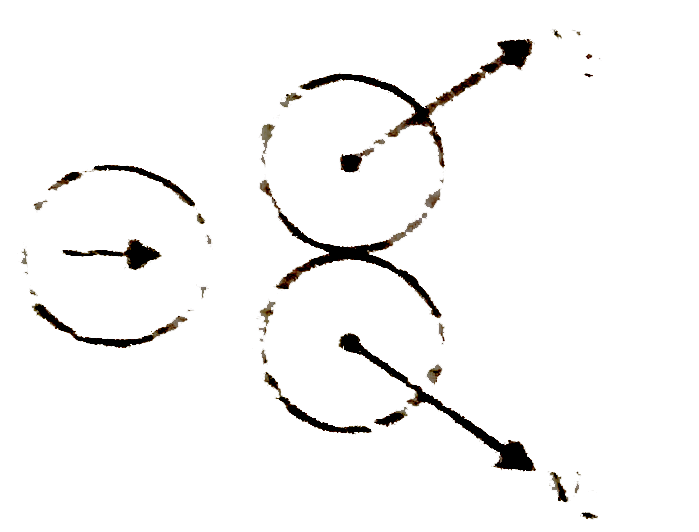A spherical ball of mass 1kg moving with a uniform speed of 1m/s collides symmetrically with two identical spherical balls of mass 1kg each at rest touching each other. If the two balls move with 0.5m/s in two directions at the same angle of 60∘ with the direction of the first ball, the loss of kinetic energy on account of the collision is :-Solution in Gujrati
0.125J
0.5J
1.0J
0.75J
The correct Answer is:A
m×1=mv1+(2mv2×cos60∘)
⇒v2=12 & v1=12
(KE)Initial=12×1×12=0.5J
(KE)initial=12(1)×(12)2+{12×1+×(12)2}×2
=0.25+0.125=0.3755
ΔKE=0.5−0.375=0.125J

Topper's Solved these Questions
- BOOK - ALLEN CHAPTER - CENTRE OF MASSEXERCISE - EXERCISE-III41videos
CENTRE OF MASS
- BOOK - ALLEN CHAPTER - CENTRE OF MASSEXERCISE - EXERCISE-IV A32videos
CENTRE OF MASS
- BOOK - ALLEN CHAPTER - CENTRE OF MASSEXERCISE - EXERCISE-I40videos
CENTRE OF MASS
- BOOK - ALLEN CHAPTER - BASIC MATHEMATICS USED IN PHYSICS &VECTORS EXERCISE - EXERCISE-IV ASSERTION & REASON11videos
BASIC MATHEMATICS USED IN PHYSICS &VECTORS
- BOOK - ALLEN CHAPTER - ELASTICITY, SURFACE TENSION AND FLUID MECHANICSEXERCISE - Exercise 5 B (Integer Type Questions)3videos
ELASTICITY, SURFACE TENSION AND FLUID MECHANICS
Similar Questions
A particle of mass m, kinetic energy K and momentum p collision head on elastically with another particle of mass 2m at rest. After collision. :
Column IColumn II(A)Momentum of first particle(p)3/4p(B)Momentum of second particle(q)−K/9(C)Kinetic energy of first particle(r)−p/3(D)Kinetic energy of second particle(s)8K9None05:41View SolutionFig. shown a uniform square plate from identical squares at the corners can be removed. (a) Where is the centre of mass of the plate originally ? (b) Where is it after square 1 is removed ?
(c ) where is it after squares 1 and 2 are removed ? (d) Where is c.m after squares 1,2,3, are removed ?
(f) Where is c.m after all the four squares are removed ? Answer in terms of quadrants and axes.
 05:28View Solution
05:28View SolutionThe centre of mass of a non uniform rod of length L whoose mass per unit length varies as p=kx2/L, (where k is a constant and x is the distance measured form one end) is at the following distances from the same end
03:59View SolutionAssertion: If the initial and final positions coincide, the displacement is a null vector.
Reason: A physical quantity can not be called a vector, if its magnitude is zero.10:27View SolutionTwo soap bubbles A and B are kept in a closed chamber where the air is maintained at pressure 8N/m2.The radii of bubbles A and B are 2cm and 4cm, respectively. Surface tension of the soap-water used to make bubbles is 0.04N/m. Find tha ratio nB/nA, where nA and nB are the number of moles of air in bubbles A and B, respectively. [Neglect the effect of gravity.]
03:14View SolutionA ball moving with a speed of 9m//s strikes an identical ball at rest, such that after the collision, the direction of each ball makes an angle of 30^(@) with the original line of motion. Find the speeds of the two balls after collision.
03:38View SolutionA ball A of mass 1 kg , moving with a speed of 12 m//s , collides obliquely and elasticity with another ball B which was initially at rest. Ball A then moves off at the right angle to its initial direction with a speed of 5 m//s . The momentum of ball B after the collision is
02:22View SolutionIf two balls each of mass 0.06 kg moving in opposite directions with speed 4 m//s collide and rebound with the same speed , then the impulse imparted to each ball due to other is
08:12View SolutionA ball of mass m moving with a velocity v undergoes an oblique elastic collision with another ball of the same mass m but at rest. After the collision if the two balls move with the same speeds , the angle between their directions of motion will be:
05:16View SolutionA ball moving with a speed of 10" m s"^(-1) strikes an identical ball such that after the collision the direction of each ball makes an angle 45^(@) with the original line of motion. Find the speeds of the two balls after the collision.
03:59View SolutionTwo billiard balls each of mass 0.05 kg moving in opposite directions with speed 6 m s^(-1) collide and rebound with the same speed. What is the impulse imparted to each ball due to the other ?
04:03View SolutionTwo billiard balls each of mass 0.05 kg moving in opposite directions with speed 6 m s^(-1) collide and rebound with the same speed. What is the impulse imparted to each ball due to the other ?
06:14View SolutionTwo billiard balls each of mass 0.05 kg moving in opposite directions with speed 6ms−1 collide and rebound with the same speed. What is the impulse imparted to each ball due to the other ?
03:42View SolutionTwo billiard balls each of mass 0.05 kg moving in opposite directions with speed 6ms−1 collide and rebound with the same speed. What is the impulse imparted to each ball due to the other ?
05:25View SolutionIf two balls each of mass 0.06kg moving in opposite directions with speed 4m/s collide and rebound with the same speed , then the impulse imparted to each ball due to other is
02:31View SolutionIf two balls each of mass 0.06kg moving in opposite directions with speed 4m/s collide and rebound with the same speed , then the impulse imparted to each ball due to other is
04:26View Solution

